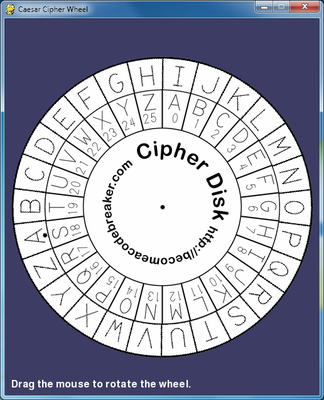
I'm focusing on readability for my answer. Reading Python's style guide,, will be a great help. But I'll highlight specific areas in your code here. Function names should always be lowercase. Classes should use PascalCase, so your Crypt will look like it's a class. Comma separated sequences in Python should have spaces after each comma, just like they would when writing an english sentence.
It's more readable. Def crypt(string, key, encrypt=1): encrypt shouldn't be an int.
Implementing a Basic Substitution Cipher in Python Written by Dan Sackett on January 15, 2015. As I progress in my Cryptography class, I find myself very immersed in things. In fact, I think crypto work is one of my new muses. It's fun to think about how to take a plaintext string and convert that to a ciphertext string and then back again. Cryptography with Python Implementing Vignere Cipher. Decryption of Transposition Cipher, Encryption of files, Decryption of. Hacking Monoalphabetic Cipher.
It should be a boolean. I know that you get user input for it, but just pass a check to see if the user entered 1 or not. Crypt(message, key, encrypt_question == '1') You can get your alphabet string programmatically instead of typing all the characters. The can be imported and will provide you with ways to get the uppercase and lowercase letters, digits and punctuation marks of a user's locale. This also makes your script more compatible with different languages. (Note: that if you use this you'll need to have a different name for the string parameter, I use often use s but single letter names are debateable) alphabet = 2 * (string.letters + string.digits + string.punctuation + ' ') On that note, alphabet is a bad name.
You're including a lot more than the alphabet but the name makes it sound like numerical characters and punctuation are unsupported. Characters is better, or chars. Synthesia unlock key code. You can use Python's floor division operator to avoid getting a float.  It's just an extra slash and will make Python round down to an int. While I'm at it, add space on either side of operators like this.
It's just an extra slash and will make Python round down to an int. While I'm at it, add space on either side of operators like this.
It's more readable. Lenalpha = len(alphabet) // 2 Don't repeat the comments here, they're practically identical anyway. Just make it less specific and put one before the if. # Shift each letter along char by a pseudo-random amount based on the key if encrypt: Instead of while finished_with_the_user, just use while True and then break when the input is valid. Again about naming, is_encrypt, do_encrypt or maybe even encrypt would be better. The question part isn't helpful to know what the variable is for, it just tells you where the value came from, but we don't care about that.
Download rain and the rhinoceros pdf free. Illustrated by Mark Grundig, this volume will delight, educate and amuse.
I also recommend making it clearer to the user what a valid input is if they provide a wrong one. While True: encrypt_question = input('Encrypt or decrypt a message? (1,0): ') if encrypt_question in ('0', '1'): break print('Please input a valid number, either 0 for decrypt or 1 for encrypt.' I find your documentation ambiguous and not clear: This program will input a message, a key, and the decision to encrypt or decrypt the message.
Reading this, it looks like the program will supply x,y,z as input to something else (another program? A website?), careful reading shows that it receives these values as input. There is no message in the method arguments: Crypt(string,key,encrypt=1), when describing what the arguments do, use the same name in code and docs.